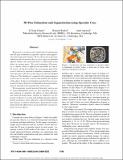3D pose estimation and segmentation using specular cues
Author(s)
Raskar, Ramesh; Agrawal, Amit; Chang, Ju Yong
DownloadChang-2009-3D pose estimation and segmentation using specular cues.pdf (1.203Mb)
PUBLISHER_POLICY
Publisher Policy
Article is made available in accordance with the publisher's policy and may be subject to US copyright law. Please refer to the publisher's site for terms of use.
Terms of use
Metadata
Show full item recordAbstract
We present a system for fast model-based segmentation and 3D pose estimation of specular objects using appearance based specular features. We use observed (a) specular reflection and (b) specular flow as cues, which are matched against similar cues generated from a CAD model of the object in various poses. We avoid estimating 3D geometry or depths, which is difficult and unreliable for specular scenes. In the first method, the environment map of the scene is utilized to generate a database containing synthesized specular reflections of the object for densely sampled 3D poses. This database is compared with captured images of the scene at run time to locate and estimate the 3D pose of the object. In the second method, specular flows are generated for dense 3D poses as illumination invariant features and are matched to the specular flow of the scene. We incorporate several practical heuristics such as use of saturated/highlight pixels for fast matching and normal selection to minimize the effects of inter-reflections and cluttered backgrounds. Despite its simplicity, our approach is effective in scenes with multiple specular objects, partial occlusions, inter-reflections, cluttered backgrounds and changes in ambient illumination. Experimental results demonstrate the effectiveness of our method for various synthetic and real objects.
Date issued
2009-08Department
Program in Media Arts and Sciences (Massachusetts Institute of Technology)Journal
IEEE Conference on Computer Vision and Pattern Recognition, 2009. CVPR 2009.
Publisher
Institute of Electrical and Electronics Engineers
Citation
Ju Yong Chang, R. Raskar, and A. Agrawal. “3D pose estimation and segmentation using specular cues.” Computer Vision and Pattern Recognition, 2009. CVPR 2009. IEEE Conference on. 2009. 1706-1713. © 2009 IEEE
Version: Final published version
ISBN
978-1-4244-3992-8
ISSN
1063-6919